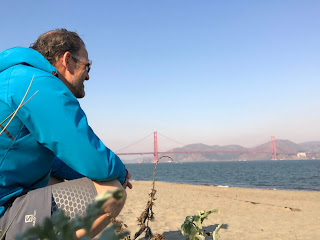being curios like a kid and evolve tension after tension
Finally,
the day on which my holacracy coach training starts! But first of all I got up
early and took the chance to discover the San Francisco’s Bernal Heights, which
are just in the neighborhood of where I stay. So, what I did, was kind a trail-running
session in San Francisco – in the middle of the city. Because in each direction
you look from the bernal heights, you see districts of the city or freeways or
the bay area!
For
that I got just the right time, because the sun just came up and presented itself
the same way she set down yesterday in Santa Cruz – as a huge fireball!
Then
on top of the hill a large swingset attached to a tree took all of my attention!
Of course, I had to test it! It just reminded me, that we should never forget to hink like a child - curious and openminded. What a great feeling and what a great situation. All
alone in the red morning light, on a hill in the middle of the City and having the
city by your feet swinging on a swingset.. I had to take a video on that.. ;-)
At
8:15 I arrived at the Producer’s Loft at the Folsom Street 2773, by the way a
very nice location used for photography or movie takes with an inbuilt studio kitchen.
Sascha, our cook, was already preparing a very nice breakfast and later on a delicious
lunch and snack in between as well.
Sasch and the studio kitchen
our setup
At
nine o’ clock Brian Robertson started the session! The introduction round was
great to hear from where all over the world participants have been joining the four
day training. Beside representatives of the USA and Canada, participants also
come from Mexico, Brazil, The Netherlands, India, Dubai and Indonesia. What a
great mix of experiences. Experiences of people doing holacracy in their company
in very different cultures!
And
all of them are holding their different roles. One of the basic principles of
holacracy is the concept of roles.
According
to the constitution (link,
chapter 1.1) the organization’s partners will typically perform work for the organization
by acting in an explicitly defined role. A “role” is an organizational
construct with a descriptive name and one or more of the following:
a)
a
“Purpose”, which is a capacity, potential, or unrealizable goal that the Role
will pursue or express on behalf of the organization. Remember when I was talking about the purpose in my first blog of saturday..? That is it now..
b)
one or more
“Domains”, which are things the role may exclusively control and regulate as
its property, on behalf of the organization.
c)
one or more
“Accountabilities”, which are ongoing activities of the organization that the role
will enact.
I
can energize one or more roles and I have to fulfill the following
responsibilities for each of my roles
- I am responsible for monitoring how my role’s rurpose and accountabilities are expressed
- I am responsible for regularly
considering how to enact my role’s purpose and each of my role’s accountabilities,
by defining:
o
“Next actions”
- which are actions you could execute immediately and that would be useful to
execute immediately, and
o
“Projects”,
which are specific outcomes that require multiple sequential actions to achieve
and that would be useful to work towards.
I
can even further develop my roles, for instance in regard of their
accountabilities! This is a very powerful approach. And the main goal is, that
we have clear transparency and clarity about which role is accountable for
what. And who needs to take care of a next action or a project.
This
is totally different to what we are used to in larger enterprises, where you
have business architects defining roles which then need to be transferred into
the organization and the members of the organization are expected to adapt the
accountabilities which have been defined for them. By dealing with the roles
and the role’s purpose and accountabilities I get more clarity and my partners
in the organization too.
Today’s
training focus was set on how the organization is working on their operational
stuff to get things done in a valuable, simple and efficient way. And how we can
coach the organization does it and how it can be supported to improve the way it is set up.
And an important principle on that is "one tension at a time and on after the other" - let the system evolve based on existing tensions. Which is not easy to whitstand. Because we historically especially as managers, we intend to tell the organization how it should be.
I
already noted many things I want to focus on in our daily business and I want
to improve together with my team. One simple thing as an example, I observer,
that we often wait for a tactical meeting to address topics, which could have
been addressed during the daily business already. Because everything you do in
a tactical meeting can also be done outside and the goal is, to bring the
organization to a point, that it processes as many tensions as possible the
same way it’ll be done in a tactical meeting, but in a more direct way. Maybe
it is one of our bad habits of the past, that we want to emphasize something in
a meeting, to get more attention or whatever.. which doesn’t make sense,
because you just lose time.
The
time passed by very fast today.. with a lot of impressions, inputs, experiences
and refinements by Brian.
I
am looking forward for day 2 which focusses on governance. But for today I
focus on the downtown of the city and hunt for the gifts I should bring home.
Folsom Street - San Francisco
Sense a tension - Write it down
SF Downtown - Powell Station












Comments
Post a Comment